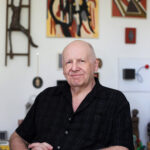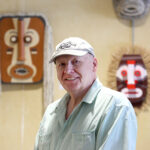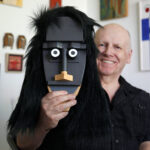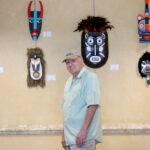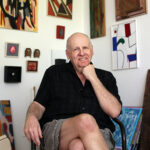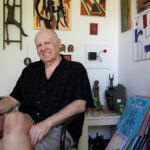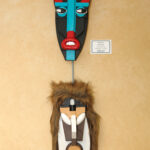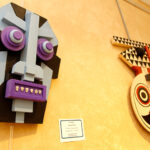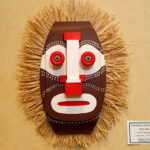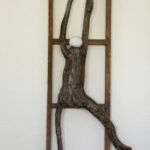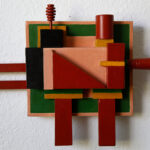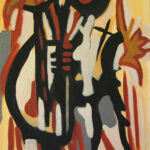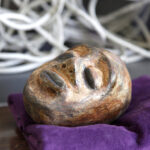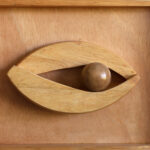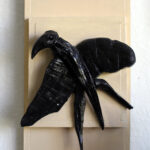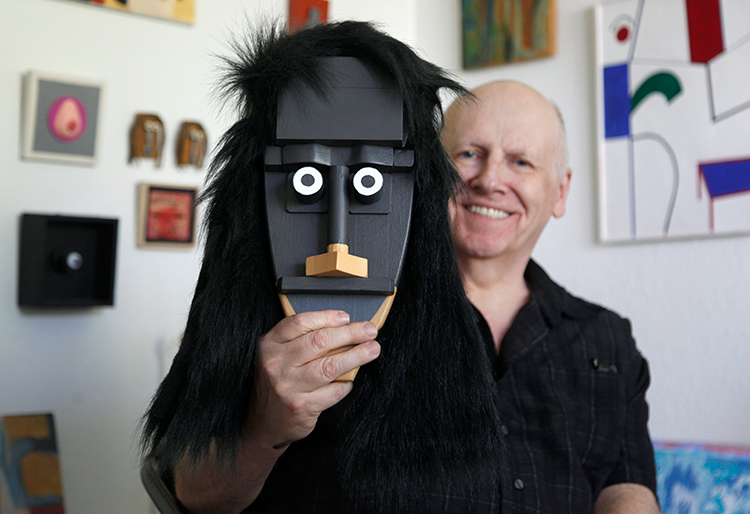
Artist Steve Reid says that art saved him from the trauma of a bleak Scottish childhood filled with rejection and pain that was deeply imbedded in his psyche. His mother and father had abandoned him, leaving him in the care of his paternal grandmother, a stern woman who put him through “some harrowing times.”
However, she also sent him to the Glasgow School of Art, which would ultimately change his life. Creativity provided a way to analyze his past and wrestle his demons.
“It was an escape,” Reid, 68, says. “It was also a gift.”
That role in the creative process is revealed in “Not Myself,” a collection of more than two-dozen masks displayed in various locations throughout the first floor of Building B at the Indian River County Administration Complex. The solo show runs through Sept. 29 as part of the Cultural Council of Indian River County’s Art in Public Places program.
“They’re interpretations of indigenous works,” says Reid, a Vero Beach resident. “They’re not exact copies. When I’m making them, I’m not setting out to make a happy or frightening face. I’m making them as they talk to me; some are benign, and some are very angry and frightening.”
Actually, he says wife, Joan, is glad they’re out of the house.
“My wife hates these,” he says with a laugh. “I’m only allowed to have certain ones up in the living room. I tell her they’re not evil, they’re chasing evil spirits away.”
The word “powerful” is apt, says Elise Mahovlich, administration manager of the Cultural Council, which organizes the public art program.
“We were looking for something a little bit different than two-dimensional paintings,” she says. “(They) create a really powerful and fantastic exhibit.”
The masks are just one aspect of Reid’s artistic pursuits. He also creates paintings, many of them monochromatic, some vivid with bold lines, and still others exploring various patterns.
Additionally, he has a collection of post-modernist wood constructions, three-dimensional paintings and sculptures.
But percussion instruments came before those aspects of his artistic pursuits. Oh, and floral designs as well. “I’ve been kind of all over the map,” Reid says.
At age 14, Reid left Scotland to seek out his father, then an artist and drummer living in New Jersey.
“It was a traumatic move,” he says, “I wanted to be like everybody else, so I worked on an American accent. If I’m around Scottish people, I fall right back into (a brogue). When I’m not with Scottish people, I sound like everyone else.”
Emulating his father, who made a living as a drummer, Reid spent a lot of time studying music, and for about 20 years, performed as a jazz percussionist. He played in shows, at cabarets, concerts and weddings, and was also a studio musician in Manhattan.
Around the same time, he became a floral designer, studying with Dries Alberts from the Netherlands, at the New York Botanical Gardens and at the Arts Student League in New York City, and began “getting wonderful paychecks.”
“I was doing both, working as an artist during the day, then at night, put on a tuxedo and played gigs,” he says.
He says life took another turn as “that slowly fell by the wayside, and I just started painting and making objects.”
Reid says he initially employed aggressive brush strokes, painting with acrylics on canvas and Masonite, utilizing a style that was not at all “dainty.” Rather, his large, percussive gestures matched his skills as a drummer.
He next turned to sculptural art, utilizing the three-dimensional qualities and natural material facets of floral design. He now primarily uses wood in a collage approach, shaping, cutting, sanding, joining, drilling and occasionally carving with a knife. His pieces are stained and at times he adds in extras, such as hair.
“I’d think of the flowers,” he says. “You’re looking at lines, parallel, horizontal, space, all of that. That was a link for me; to go into object making and more sculptural pieces, which is harder to sell. When you’re looking at a pretty picture – a beach, a fence and a little pathway and the sea and a boat sailing across – it’s beautiful. But to me, it’s vacant.”
However, he says, “when you look at minimalism, and you’re staring at white paintings or pure black paintings, or a piece of work that is almost monochromatic, and might have two shades, it changes, and can alter the endorphins and your subconscious mind and put you into a more meditative space without you realizing it.”
Reid next took a closer look at the capability of art having a “function” as well as “form.” For him, that meant turning to primitive art, created, he says, to scare away bad spirits and to protect the tribe.
He realizes that today, some might consider his mask collection to be an example of “Cultural Appropriation,” using iconic elements from one culture by a person from another culture in a way that demeans or disrespects its original use, although that was not his intent.
“It’s a very good point,” Reid says. “I apologize. I don’t have quite the answer to that. They are created because they speak to me.”
Reid says he pays homage to the masks’ original use and function – protection. His study of their usage spoke to him and helped him to confront the emotional pain he had suffered in his youth.
“They have been highly abstracted, too. Black Africans were making these hundreds of years before Picasso, who was very influenced by Black African masks. And Matisse was, also.”
Moreover, Reid hopes people will get from the show something far more than viewing items as decorative items on a wall, but rather as a glimpse into themselves.
“Look at them as a kind of mirror into themselves, into their own psyches,” he says. “They’re a way of letting go of ego-centeredness. I would hope that they evoke certain emotions they wouldn’t normally see in a gift shop.”
The first mask he made was years ago. He was in upstate New York and took an empty gallon milk container, turned it upside down, used the handle for the nose and painted on it “really, really scary eyes.” He couldn’t sleep for two weeks, so he had to put it away.
“I scared myself,” he says.
“But now, I can live with some of these things.”
Photos by Kaila Jones

